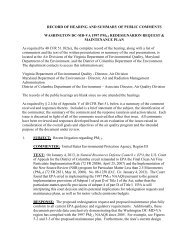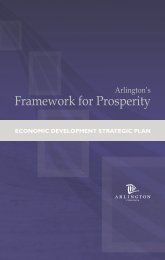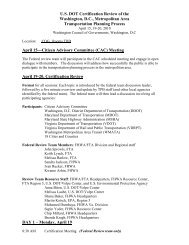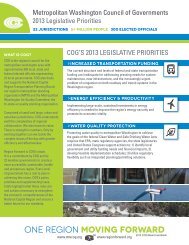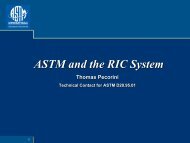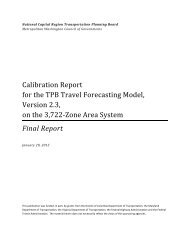PTI Local Government Energy Assurance Guidelines - Metropolitan ...
PTI Local Government Energy Assurance Guidelines - Metropolitan ...
PTI Local Government Energy Assurance Guidelines - Metropolitan ...
Create successful ePaper yourself
Turn your PDF publications into a flip-book with our unique Google optimized e-Paper software.
Implementation Timeline<br />
NIMS compliance should be considered and undertaken as a community-wide event. By the end of the Federal<br />
Fiscal Year 2006 (September 2006), DHS/FEMA required that NIMS be adopted at the community level for all<br />
government departments and agencies (Tribal <strong>Government</strong> and <strong>Local</strong> Jurisdiction Compliance Activities: Federal<br />
fiscal year 2006). This could be done through a formal executive order, a proclamation, resolution, or legislation.<br />
This was to be done in concert with NIMS local government outreach to associations, utilities, non-governmental<br />
entities, and private sector incident management and response organizations. 54<br />
Incident response organizations are numerous and include:<br />
■■<br />
■■<br />
■■<br />
■■<br />
■■<br />
■■<br />
■■<br />
Public health organizations<br />
Medical service organizations<br />
Private sector entities (especially energy utilities)<br />
Law enforcement officials<br />
Fire officials<br />
Public works officials<br />
Emergency management officials and others<br />
<strong>Local</strong> <strong>Government</strong> Goals for NIMS<br />
When NIMS is fully implemented, the local community or jurisdiction will be able to:<br />
■■<br />
■■<br />
■■<br />
■■<br />
■■<br />
■■<br />
Ensure common and proven incident management doctrine, practices, and principles are used to plan for,<br />
protect against, respond to, and recover from emergency incidents and preplanned events.<br />
Maintain a response operation capable of expanding to meet an escalating situation and the ability to integrate<br />
resources and equipment from intrastate and interstate mutual aid agreements, State-provided assistance, and<br />
Federal government response.<br />
Order and track response assets using common resource typing and definitions, and draw on mutual aid<br />
agreements for additional assistance.<br />
Establish staging and allocation plans for the re-distribution of equipment, supplies, and aid coming into the<br />
area from other localities, States, or the Federal government through mutual aid agreements.<br />
Conduct situational assessments and establish the appropriate ICS organizational structure to effectively<br />
manage the incident.<br />
Establish communication processes, procedures, and protocols that will ensure effective interoperable<br />
communications among emergency responders, 911 centers, and multi-agency coordination systems<br />
(emergency operations centers).<br />
C.5 <strong>Energy</strong> Emergency <strong>Assurance</strong> Coordinators System<br />
The Department of <strong>Energy</strong>’s Office of Electricity Delivery and <strong>Energy</strong> Reliability (DOE/OE) maintains a passwordprotected<br />
<strong>Energy</strong> Emergency <strong>Assurance</strong> Coordinators (EEAC) website through which authorized State and local<br />
54<br />
The NIMS Integration Center is responsible for managing a helpful “NIMS On-Line” web site at http://www.nimsonline.com/.<br />
88 | Appendix C – Federal <strong>Energy</strong> <strong>Assurance</strong> Planning and Response Initiatives



